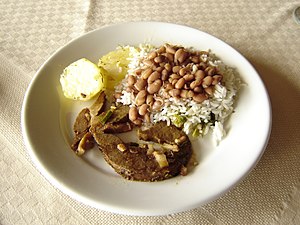This is an old revision of this page, as edited by Boston (talk | contribs) at 23:39, 16 March 2009 (African rice). The present address (URL) is a permanent link to this revision, which may differ significantly from the current revision.
Revision as of 23:39, 16 March 2009 by Boston (talk | contribs) (African rice)(diff) ← Previous revision | Latest revision (diff) | Newer revision → (diff)
Rice and beans (called arroz y habas, arroz con habichuelas, arroz con frijoles or similar in Spanish, arroz e feijão or feijão com arroz, in Brazilian Portuguese, diri ak pwa in Haitian Creole, etc.) is a very popular dish throughout Latin America and the Caribbean as well as in communities of Latino and Caribbean people elsewhere.
Given the basic nature of its ingredients, rice and bean dishes exists in many regions of the world. This article, however, is primarily concerned with the Americas.
Description
The dish usually consists of white rice accompanied by brown, red or black, dry beans (typically Phaseolus vulgaris or Vigna unguiculata) and seasoned in various ways. Different regions have different preferences. In Brazil, for example, black beans are more popular in Rio de Janeiro, Rio Grande do Sul and Santa Catarina, while in most other parts of the country these are mostly only used in feijoadas. The New Orleans specialty known as "red beans and rice" is often accompanied by a side of smoked sausage or a fried pork chop.
In many areas, rice and beans are often served side by side rather than mixed together. Either way, they may be considered a meal or as a side dish to accompany a main dish of meat or chicken. Meat or other ingredients are sometimes placed atop rice and beans or (less often) mixed into it.
Importance
While simple, the dish is very nutritious. Rice is rich in starch, an excellent source of energy. Rice also has iron, vitamin B and protein. Beans are also protein-rich, and contain a good amount of iron and other necessary minerals, and both offer an important and basic kind of protein. One authority writes:
Rice and beans are an inseparable pair of staple foods for millions of Latin Americans, parts of Central America, the Caribbean, and the Andean Mountain zone. Whether consumed separately or together, these crops figure importantly in the human diet and in national economies across the entire region, and trends in their production are a matter of immediate relevance to practically all of its inhabitants.
Often available even when times are hard, a Nicaraguan explained life after Hurricane Mitch by saying:
For breakfast, we have beans and rice. For lunch, we have rice and beans. For supper, we have rice and beans mixed together.
Rice and beans together create a complete protein, not available in just rice or beans alone.
History
Unlike certain varieties of bean, rice is not native to the Americas. According to widely-accepted scholarship, rice was introduced to the Caribbean and South America by European colonizers at an early date with Spanish colonizers introducing Asian rice to Mexico in the 1520s at Veracruz and the Portuguese and their African slaves introducing it at about the same time to Colonial Brazil. More recent scholarship suggests that African slaves played a more active role in the establishment of rice in the New World and that African rice was an important crop from an early period.
In either case, varieties of rice and bean dishes were a staple dish along the peoples of West Africa and they remained a staple among their descendants subjected to slavery in the Spanish New World colonies and elsewhere in the Americas.
Culture
In discussing Puerto Rican cuisine, a food critic wrote:
Rice and beans are sacred .... They are our "daily bread," our comfort food. When you mess with someone's rice & beans, you mess with their mind. Rice & beans are soul food I ordered Arroz con habichuelas and when they arrived, I poured the entire bowl of beans over the plate of rice and mixed them thoroughly to absorb the gravy. I mention mixing because rice & beans are eaten together in the same bite and not, as I saw the uninitiated do, eaten separately in isolated mouthfuls. It's a synergistic dish and makes a deliciously healthy block of complete protein when combined together.
Today, the term "rice and beans" is used as a metonym for basic needs of food and phrases such as "the poor can't afford their rice and beans" are frequent. It is also used more generally for anything that is basic, fundamental, or simple in phrases like "just do the rice and beans and you'll succeed". The term is also used to describe any pairing that works together well, such as "they're like rice and beans".
See also
- Cuisine of Puerto Rico
- Cuban Cuisine
- Haitian Cuisine
- List of Brazilian dishes
- Louisiana Creole cuisine
- Gallo pinto, a Nicaraguan/Costa Rican version of rice and beans
- Platillo Moros y Cristianos, a Cuban version of rice and beans
- Rice and peas, a Jamaican staple dish
- Kongbap, a Korean rice and beans dish
References
- Puerto Rican White Rice and Kidney Beans
- Centro Internacional de Agricultura Tropical 2001
- 'Stories Bear Fruit: Sustenance for the Journey' is the theme for supporters' testimonies at The Fig Tree's 2008 Benefit
- Slavery in America: Rice and Slavery
- Black Rice: The African Origins of Rice Cultivation in the Americas by Judith A. Carney
- National Research Council (1996-02-14). "African Rice". Lost Crops of Africa: Volume I: Grains. Lost Crops of Africa. Vol. 1. National Academies Press. ISBN 978-0-309-04990-0. Retrieved 2008-07-18.
{{cite book}}: Cite has empty unknown parameter:|origdate=(help); External link in|chapterurl=|chapterurl=ignored (|chapter-url=suggested) (help) - Tables magazine.
- Scolari On Alves, Rice, Beans, Maniche & Ronaldo
Bibliography
- Embrapa, Origem e História do Arroz and Origem e História do Feijão (in Portuguese)
- Arroz e Feijão: Uma dupla infalível, Camaquã Alimentos (in Portuguese)